- Home >
- Products >
- Technical Highlight >
- Vol.17: TRUSTARC™ CM-95B91 (E9015-B91) and TRUSTARC™ CM-96B91 (E9016-B91) applied to ASTM T91/P91 heat resistant steels for fossil-fuel thermal power generation >
Technical Highlight Vol.17
Vol.17: TRUSTARC™ CM-95B91 (E9015-B91) and TRUSTARC™ CM-96B91 (E9016-B91) applied to ASTM T91/P91 heat resistant steels for fossil-fuel thermal power generation

1. Preface
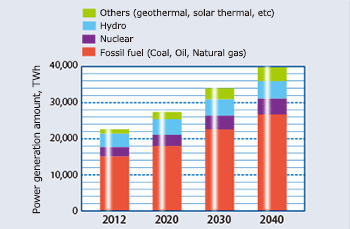
Note: TWh=Terawatt hour
Figure 1: Forecast of worldwide sources of
electric power generation (1)
Today, 60% of electric power worldwide is generated from fossil-fuels such as coal, petroleum, and natural gas as shown in Figure 1, and it is forecast that the similar ratio will be maintained even after 2020.
Because the generation of thermal power from fossil fuels raises such issues as conservation of resources and reduction of costs as well as the emissions of carbon dioxide (CO2), the improvement of power generation efficiency has long been a topic of intense research. Currently, efficiency is gained by forcing high temperature steam into power generating turbines at high pressure, which, naturally, means that steel materials are utilized under harsh steam conditions. One type of steel engineered to withstand such severe conditions is high Cr ferritic heat resistant steel containing 9 to 12 % Cr.
Because its thermal expansion coefficient is smaller than austenitic heat resistant steel, high Cr ferritic heat-resistant steel is more useful in thermal power generation, which requires repeated starts and stops in response to electric power demand. The typical high Cr ferritic heat resistant steel is ASTM T91 and P91 steel (modified 9Cr-1Mo steel, hereinafter called T91/P91), which has been applied in large numbers of thermal power boilers.
Kobe Steel has developed and marketed welding consumables for T91/P91 steel such as the 9Cb series, which has been applied in thermal power plants in Japan for decades, and the B9 series, which matches with AWS specifications. In this issue, we discuss some recent trends in international standards as well as the covered arc electrodes, TRUSTARC™ CM-95B91 and TRUSTARC™ CM-96B91, both of which have newly been developed to meet AWS A5.5: 2014 specifications for T91/P91 steel.
[Trade designation is omitted later.]
2. Recent trends in international standards
| Year | Mn+Ni content (mass %) | Upper limit of PWHT temperature for production (°C) | Reference (Year of revision) | |
|---|---|---|---|---|
| Recommended condition | Mandatory condition | |||
| 2008 and before | Not regulated | 760 | Base metal Ac1: about 800 | Table 132 P-No. 5B Group No. 1→ Group No. 2 (2007) |
| 2009-2013 | Filler metal: unknown | 775 | Base metal Ac1 : about 800 | Table 132 P-No. 15E Group No. 1 (2009) |
| 1.0 ≤ Filler metal < 1.50 | 790 | |||
| Filler metal < 1.0 | 800 | |||
| 2014 and after | Filler metal < 1.2 | 775 | Base metal Ac1: about 800 and filler metal A1 or Ac1*2 | Table 132 P-No. 15E Group No. 1 (2014) |
| < 1.0*1 | - | 125.1.3 (2014) For repairing castings | ||
| Note: *1 B9: SMAW, SAW, GTAW and FCAW *2 A1 or Ac1 in filler metals is determined either by analysis and calculation or by actual measurement. |
||||
| Year | Upper limit of Mn+Ni content in deposited metal*1 (mass %) | Upper limit of PWHT temperature at classification test (°C) | Reference (Year of revision)*2 |
|---|---|---|---|
| 2004 and before | Not regulated*3 | 759 (SMAW)or 760 | B9: SMAW, GMAW, GTAW (1996), SAW (1997) |
| 2005-2010 | 1.5 or 1.50 | 775 | B9: GMAW, GTAW (2005), SMAW (2006), SAW (2007), FCAW (2010) |
| 2011 and after | 1.40 | 775 | B9 deleted→B91 newly established B91: SAW (2011), FCAW (2012), SMAW (2014)*4 |
| Note: *1 Wire or cut rod chemistry in case of GMAW and GTAW *2 AWS Specification No.: SMAW: A5.5; SAW* A5.23; GMAW & GTAW: A5.28; FCAW: A5.36. *3 Sum of both Mn and Ni specified upper limit is 2.25. *4 Revision of GMAW and GTAW is under discussion as of 2015 |
|||
| Year | Upper limit of Mn+Ni content (mass %) | Upper limit of PWHT temperature for production (°C) | Reference |
|---|---|---|---|
| 2012 | 1.0*1 | - | Code Case 2192-8 B9 For repairing cast products |
| 2013 | 1.2*2 | - | Sect. I, PW-5.4, B9 For high-pressure resistant members |
| Note: *1 SMAW, SAW, GTAW and FCAW *2 SMAW, SAW, GTAW, FCAW and GMAW |
|||
| Year | Upper limit of Mn+Ni content (mass %) | Upper limit of PWHT temperature for production (°C) | Reference |
|---|---|---|---|
| 2011 | 1.00 (FCAW: 1.50) | 770 | Report No. 1023199 SMAW, SAW, FCAW, GMAW/GTAW |
| 2014 | -*1 | - | Report No. 3002003472 Proposal of optimizing chemical compositions for P91 steel |
| - | -*2 | Report No. 3002004370 Proposal of manufacturing guidance for P91 steel | |
| 2015 | 1.00*4 (FCAW: 1.50*4) | 770*4 | Report No. unknown*3SMAW, SAW, FCAW, GMAW/GTAW |
| Note: *1 Sum of both Mn and Ni specified upper limits is 0.70. *2 Upper limit of tempering temperature is 770 °C. *3 Revision of Report No. 1023199 (2011) is under discussion. *4 Estimated figures due to *3, report above under discussion. |
|||
International standards related to welding consumables for T91/P91 steels have significantly changed in the last ten years. Key changes relate to the requirements for Mn+Ni content and the post weld heat treatment (PWHT) temperatures that are closely related to the Mn+Ni content. Tables 1 and 3 show how the standards have been modified by the American Standard of Mechanical Engineers (ASME, the manufacturing standard), while Table 2 shows the AWS standards (the welding consumable standard) and Table 4, those of the Electric Power Research Institute (EPRI, the industry organization).
For T91/P91 steel welded joints, PWHT is indispensable in order to reduce residual stress. However, the creep rupture strength and/or notch toughness of those weld metals can become unstable if the PWHT temperature exceeds their Ac1 transformation temperature (Ac1), because fresh martensite* microstructure can begin to form.
*Fresh martensite can form through a martensitic transformation occurring during a high temperature austenitic phase as temperature drops due to the PWHT temperature exceeding Ac1. Fresh martensite shows the same high strength/low toughness features as martensite because it has not been tempered by PWHT.
For the reasons discussed above, the upper limits on ① Mn+Ni content and ② PWHT temperature have been continuously revised in all the standards. What they all have in common is to prevent the formation of fresh martensite.
The latest versions of typical international standards specify as follows:
・ASME (B31.1: 2014) ① 1.2 %; ② A1 or Ac1
・AWS (A5.5: 2014) ① 1.40 %; ② 775 °C
・EPRI report (No. 2023199: 2011) ① 1.00 %; ② 770 °C
One may ask how Ac1 is measured internationally. ASTM A1033-04 specifies a method for measuring the transformation point of carbon steel and low alloy steel. However, no international standard specifies test conditions such as measuring method or rates of increasing or decreasing temperatures in order to measure Ac1 for high Cr ferritic heat resistant steels.
Kobe Steel has frequently discussed those conditions, and the round robin test for T91/P91 steels has finally been adopted at the International Institute of Welding (IIW) in 2013. We were the only welding consumable manufacturer in the world to participate in it.
3. CM-95B91 (AWS A5.5 E9015-B91) and CM-96B91 (AWS A5.5 E9016-B91)
Japanese laws and regulations specify a maximum PWHT temperature of 760°C for T91/P91 steels. Because Kobe Steel’s 9Cb series, such as CM-9Cb (AWS A5.5 E9016-G), TG-S9Cb (AWS A5.28 ER90S-G), have been tested and confirmed as acceptable for PWHT temperature over Ac1 and up to 780°C(2), they continue to be recommended for projects of the like in Japan.
Kobe Steel has proposed to the AWS A5 committee modified specifications to the 9Cb series, such as an upperlimit of 760°C as the PWHT temperature at classification test.
On the other hand, as discussed above, a PWHT temperature of 760°C or higher is now specified in recent international standards and has been requested by many fabricators for recent overseas projects that are meant to comply with international standards like AWS, ASME, EPRI. In response, Kobe Steel has recently developed CM-95B91 (E9015-B91) and CM-96B91 (E9016-B91). CM-95B91 is for direct current (DC) use while CM-96B91 is recommended for alternate current (AC.)
3.1 Features of CM-95B91 and CM-96B91
These covered electrodes were designed to achieve the following three requirements:
(1)No appearance of fresh martensite microstructure, even at 760°C or higher PWHT temperature.
(2)Prevention of residual δ ferrite (which degrades long term creep rupture strength) remaining in the deposited metal.
(3)Long-term creep rupture strength of deposited metal that is equal or better than T91/P91 steel.
CM-95B91 and CM-96B91 are designed to maintain the lower limit of PWHT temperature as specified in AWS, that is, 745°C (=760-15). Table 5 shows the typical chemical compositions of their deposited metals as well as the latest AWS A5.5: 2014 specifications.
| C | Si | Mn | P | S | Cu | Ni | Co | Cr | Mo | V | Nb | Al | N | Mn+Ni | N/Al | X bar*3, ppm | |
|---|---|---|---|---|---|---|---|---|---|---|---|---|---|---|---|---|---|
| CM-95B91 | 0.10 | 0.20 | 0.64 | 0.008 | 0.004 | 0.02 | 0.10 | 0.40 | 8.20 | 0.90 | 0.20 | 0.05 | <0.01 | 0.03 | 0.74 | 14 | 7 |
| CM-96B91 | 0.10 | 0.21 | 0.63 | 0.008 | 0.004 | 0.03 | 0.10 | 0.40 | 8.45 | 0.98 | 0.19 | 0.05 | <0.01 | 0.03 | 0.73 | 15 | 7 |
| AWS A5.5:2014 E901X-B91*1 | 0.08 - 0.13 | 0.30 max. | 1.20 max. | 0.01 max. | 0.01 max. | 0.25 max. | 0.80 max. | *2 | 8.0 - 10.5 | 0.85 - 1.20 | 0.15 - 0.30 | 0.02 - 0.10 | 0.04 max. | 0.02 - 0.07 | 1.40 max. | (4 min.) | (15 max.) |
| Note: *1 X in E901X shall be either 5 (for DC only) or 6 (DC or AC). *2 If intentionally added, it must be reported. *3 X bar = (10P + 5Sb + 4Sn + As)/100 (ppm) |
|||||||||||||||||
3.1.1 Optimum addition of Mn and Ni
Because a large amount of Cr (a ferrite forming element) is contained in welding consumables for T91/P91 steels, δ ferrite, which lowers long-term creep rupture strength, tends to remain in the weld metal. Therefore, by adding Mn+Ni, an effective chemical composition is created that prevents δ ferrite from remaining in the weld metal(3). On the other hand, as seen in Figure 2, the addition of Mn+Ni content lowers Ac1, leading to a higher risk of fresh martensite formation.
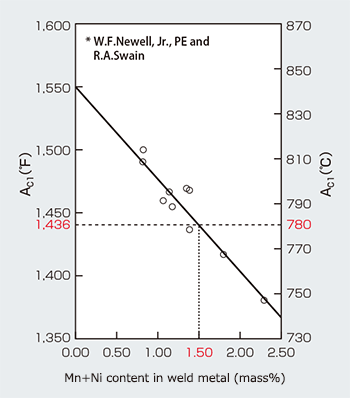
Figure 2: Relationship between Mn+Ni and Ac1 of weld
metal for high Cr ferritic steel
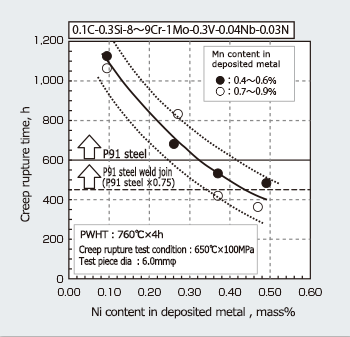
Figure 3: Relationship between Mn, Ni and creep rupture
time of deposited metal for T91/P91 steel
Figure 3 indicates the relationship between Mn and Ni and creep rupture time of deposited metal for T91/P91 steel. It can be seen that Mn is less influential than Ni on creep rupture time, which becomes longer as Ni content is reduced. It is believed that longer creep rupture life is related to the delay of lath microstructure recovery.
For these reasons, CM-95B91 and CM-96B91 are designed to contain the minimum amount of Ni necessary to lower the residual δ ferrite, and enough Mn so that the total Mn+Ni content amounts to 1.0%.
3.1.2 CNB (Cr equivalent ‒ Ni equivalent balance)
EPRI Report No. 1023199 states that T91/P91 steel products shall have a martensite single-phase structure with no δ ferrite in order to secure creep rupture strength and proposes an index by the following equation(4):
CNB = (Cr equivalent) – (Ni equivalent)
= (Cr+6Si+4Mo+1.5W+11V+5Nb+9Ti+12Al) –
(40C+30N+4Ni+2Mn+1Cu)
< 10 % (mass %)
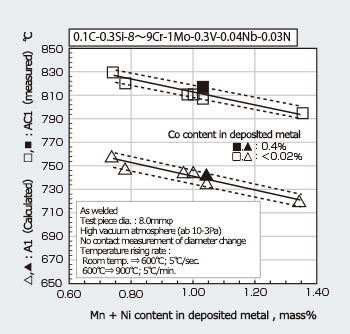
Figure 4: Relationship between Mn+Ni and Co and Ac1 and
A1 of deposited metal for P91 steel
CM-95B91 and CM-96B91 are also designed to comply with the above CNB index, so that long-term creep rupture strength can be maintained by reducing residual δ ferrite in deposited metal. Furthermore, in addition to Mn and Ni, Co is also added, which also reduces residual δ ferrite in deposited metal. Figure 4 shows the relationship between the Mn+Ni and Co content and Ac1 (measured value) and A1 (calculated by Thermo-calc.) in a deposited metal of T91/P91 steel. It can be seen that Co does not lower Ac1 and A1 even if it is added in with Mn and Ni.
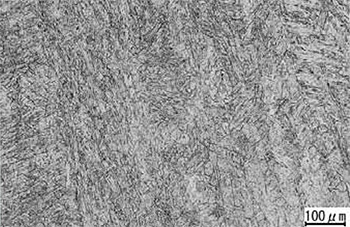
Photo 1: Microstructure of final pass deposited metal
(PWHT: 779°C × 8.0 hour)
The microstructure of CM-95B91 deposited metal is shown in Photo 1. A uniform martensite single-phase microstructure can be seen with no δ ferrite or fresh martensite.
The method of measuring the Ac1 discussed in this article involves raising the temperature of a cylindrical test piece and using a high precision LED light-emitting device to detect changes in diameter (elongation and contraction) according to temperature rise. The accuracy of this method has been verified by an advanced preliminary study(5).
3.2 Mechanical properties
The relationship between tensile properties and heat treatment parameter, commonly referred to as the Larson-Miller Parameter (LMP), on CM-95B91 deposited metal is shown in Figure 5 and the relationship between impact properties and LMP, in Figure 6, respectively.
It is understood that the tensile strength of CM-95B91 deposited metal is equal to or more than that of T91/P91 steel when PWHT ranges from LMP (×10-3): 20.6 (743 °C × 2.1 hr) to LMP (×10-3): 22.0 (779 °C × 8.0 hr).
Although there is no formal requirement for the impact properties, we have used VE20 °C ≥ 38J average as an example for comparison. If PWHT is equal to or more than 760 °C × 2.7 hr (LMP ×10-3 = 21.1), it is considered that CM-95B91 deposited metal can secure the practical level of impact properties.
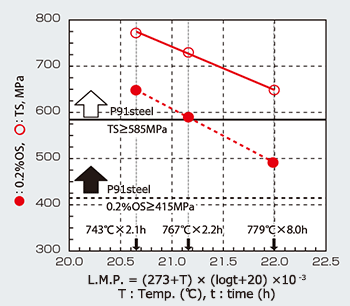
Figure 5: Relationship between tensile properties and LMP
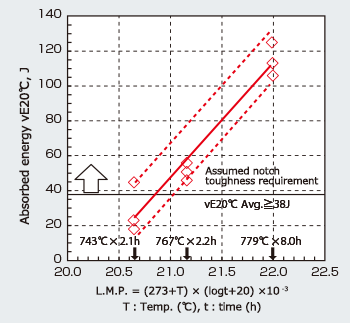
Figure 6: Relationship between impact properties and LMP
3.3 Creep rupture property
Figures 7 and 8 show the creep rupture properties of CM-95B91 deposited metal at the test temperatures of 650 °C and 600 °C, respectively.
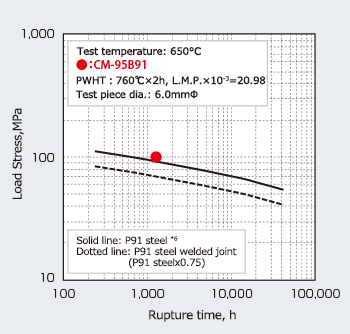
Figure 7: Creep rupture property at 650°C
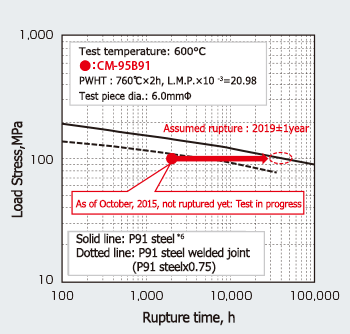
Figure 8: Creep rupture property at 600°C
The test result of CM-95B91 deposited metal at 650 °C indicates its creep rupture strength is higher than that of T91/P91 steel. The long-term creep rupture test at 600 °C, based on an assumption of rupture time of about 40,000 hours (about 4.5 years) as shown in Figure 8 is in progress.
4. Notes on usage
A high Cr ferritic heat resistant steel weld metal is more susceptible to delayed cracking due to its self-hardening properties than 1.25Cr-0.5Mo or 2.25Cr-1Mo heat resistant steel weld metal. Therefore, the following notes on usage are important:
(1) It is necessary to maintain preheating and interpass temperatures between 250 and 350°C for preventing delayed cracks.
(2) It is also essential to re-dry electrodes before use for one hour at 350-400°C to satisfy the H4 (AWS diffusible hydrogen level) requirement.
(3) Excessively high welding currents and speeds have to be avoided to prevent hot cracks as well. Kobe Steel’s welding consumables for high Cr ferritic heat resistant steels are designed to contain low amounts of P and S to prevent hot cracks. However, the deposited metal of T91/P91 steel has a wider solid-liquid coexisting temperature range than that of 1.25Cr-0.5Mo or 2.25Cr-1Mo heat resistant steel, resulting in higher susceptibility for hot cracks.
5. Postscript
This article has discussed some recent trends in international standards related to T91/P91 heat resistant steels for fossil-fuel thermal power generation, as well as the features of CM-95B91 and CM-96B91, covered arc electrodes that have been newly developed to meet these standards. These electrodes show superior qualities related to N/Al, X bar (see Table 5), H4 as well as electrode burning resistance, and they offer excellent welding workability for T91/P91 heat resistant steels for fossil-fuel thermal power generation. Given their excellent qualities for these applications, their use should become more widespread, leading to further reductions in CO2 emissions control through improved power generation efficiency.
References
(1) The Institute of Energy Economics, Japan - Asia/World Energy Outlook 2014
(2) Effects of PWHT Temperature on Mechanical Properties of High-Cr Ferritic Heat-Resistant Steel Weld Metals ‒ R & D Kobe Steel Engineering Report, Vol. 63, No. 1 (2013)
(3) Procurement of P91 Consumables, EPRI Conference on 9Cr Materials Fabrication and Joining Technologies, Session 2, 5-1 (2001)
(4) EPRI 1023199: Guidelines and Specifications for High-Reliab ility Fossil Power Plants (2011)
(5) Effect of PWHT temperature and mechanical properties of High-Cr ferritic heat-resistant steel weld metal, Welding in the World, Vol. 56, Jan-Feb (2012)
(6) National Institute for Materials Science (NIMS) Creep Data Sheet, No. 43A
Products
- Main Products
- Welding Consumables
- Arc welding robots
- Industries - Recommended Materials
- Welding Handbook Quick View
- Product Quick View & Highlights
- For HEAT-RESISTANT STEEL
- For STAINLESS STEEL
- For LOW-TEMPERATURE STEEL
- Product Highlight
- Catalog
- Technical Highlights
- Certification
- SDS ※English Only
- ARCMAN
- Welding Robot
- Software






